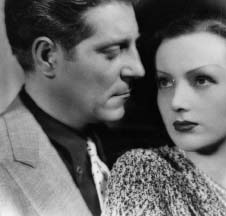
|
Pepe le Moko Classic Film ReviewAugust 13, 2002
It takes ten breathtaking minutes of coy setup for Julien Duvivier to show us the suave eponymous gangster in his near perfect 1937 prewar proto-noir Pepe le Moko. First, we must hear the frustrated police discuss how they cannot catch the miscreant within the local warren known as the Casbah. Next we are brought into this labyrinthine territory and shown a choice cross section of the exotic and cutthroat denizens who live in the area. Eventually we enter the heart of the crime boss's domain and are given the merest glimpse of our protagonist in a sweeping close-up of the palm of his outstretched hand holding a single white pearl, simple in its beauty and yet deadly in its implication. Finally then, the camera pans back to reveal the countenance of Jean Gabin in the role of le Moko and the bravura introduction is over, the director having managed in this short sequence to gain our complete sympathy for his character, notwithstanding (or perhaps because of?) whatever illicit and immoral activities he may be engaged in. Thus ensconced in Duvivier's capable hands, we traverse the Casbah proper, from smoky dens to backstreet bars, moving up and down filthy stairways filled with prostitutes and pickpockets as the drone of Arabic music echoes from the whitewashed walls. Sketchy middlemen, teahouse rats, alluring women, mute gangsters and sly cops fill the frame, lurking in darkened doorways with their unknown purposes hanging over our starcrossed antihero like a fetid miasma. Gabin cuts smoothly through all this with raffish charm, playing the lead here with all the superior talents he brought to his spectacular career, and this performance is one of the greatest in an output few actors in the history of world cinema can deign to match. His le Moko is such a commanding presence that he looms over every scene whether he's in the shot or not, dominating the narrative from its brilliant inception to its inevitable climax. But it is not simply Gabin's excellent performance that makes this entertaining film a real delight, as just about every aspect of the production makes its own unique contribution to the fascinating whole. The acting is a treasure from top to bottom; Lucas Gridoux's cagey Inspector Slimane, Gabriel Gabrio's brutish Carlos and Line Noro's gypsy femme fatale are especially of note, rising above what is overall a wonderful ensemble cast. A brisk screenplay by Henri Jeanson also helps to move things along, and the cinematography of Marc Fossard (who also shot Carne's great Children of Paradise) and Jules Kruger brings the Casbah to life, their camerawork reveling in the gritty shadows of le Moko's lair. But behind everything is the steady hand of Duvivier, who guides us through these twisted alleys and shady dives with a touch of sentimental cynicism, bringing to the gangster's tale a wistful fatalism that makes it all the more poignant and powerful. It's likely that the director's somber attitude has something to do with the general mood on the continent as the threat of war hung over Europe at the time the film was made. But this strain of pessimism was characteristic to Duvivier's work throughout his long career, as was his tendency to infuse this dark viewpoint with more romantic aspects. Moments of pensive longing crop up continually in the narrative of Pepe le Moko; from the title character's melancholy musings about his near mythic lost Paris to an old madame weepily reliving her youth via scratchy gramophone the whole outing simply oozes with a sardonic emotionalism. It's this and the general attitude of fated despair that most identify this film as a direct ancestor to the future bleak film noirs that would follow in the postwar period. Duvivier's Pepe le Moko still greatly resonates today as a movie through the simple excellence of all its parts and the way in which they are deftly woven together by the director. There is one last piece of the production that made the experience of viewing this film such a pleasure however, and it is the only part of the project's success that the Frenchman can claim no part of. Since all prints of this film were taken out of circulation when Hollywood scrubbed the piece clean and remade it as Algiers with Charles Boyer and Hedy Lamarr in 1938, it is thanks to the good people at Rialto Pictures that we are seeing this movie in its proper 35 mm format for the first time in 60 years. Also responsible for last years gorgeous restoration of Jules Dassin's first class Rififi, these folks do such great work that I anxiously await whatever it is that they're working on currently. (Aside: can I put my future vote in for a William Castle style revival of La Belle Equipe where hapless art house audiences get to vote on whether they want the happy ending or the sad ending? Failing that, I'd gladly settle for a new print of Voici le temps des Assassins or Carne's Quai des Brumes). The print that I saw looked just beautiful, and readers in San Francisco, Los Angeles, Berkeley, Downer's Grove, Illinois and Rhinebeck, New York should note that this exceptional example of the crime film is coming your way in the very near future (dates available at the Rialto Pictures website cited above). This is a rare chance to see one of the sparkling gems of prewar French sound cinema in its original form, and so you are hereby advised not to miss the opportunity. If you care anything at all about film and its historic achievements, you won't regret a single minute that you spend watching this flawless piece of cinema unfold before your eyes.
|
Friday, December 26, 2025
© 2006 Box Office Prophets, a division of One Of Us, Inc.